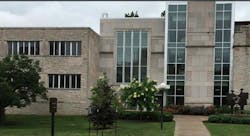Maintenance backlog at MIssouri's public colleges top $1.4 billion
A report from the Missouri Department of Higher Education says the 2,453 buildings at public colleges and universities need more than $1.4 billion in maintenance.
The Kansas City Star reports that the 195-page document described facility flaws such as ld and failing pipes, bad roofs, water-stained ceilings, hole-ridden carpets in buildings at two- and four-year colleges across Missouri
State officials assert that campuses are millions of dollars behind in building upkeep and may never catch up.
“Many of these issues cannot be resolved in the short term as capital projects and budgeting is often a multi-year process,” the report states. “As a result, many of these conditions will worsen before they are addressed, significantly increasing costs.”
Based on the findings in the report, the Missouri Coordinating Board of Higher Education recommends that the state increase funding to all institutions to address deferred maintenance, provide funds for emergency capital improvements needs at colleges and universities, and create a more needs-based approval process for state-funded campus construction.
The report is intended as a guide for colleges and universities to establish capital improvement priorities over the next decade.
Deferred maintenance data from the state show more than $1.3 billion at public universities, $118.6 million at community colleges, and $2.2 million at the State Technical College of Missouri.
"Addressing deferred maintenance and identifying funding to support new construction will be a major challenge in the coming decade – but it is one the Coordinating Board for Higher Education, public colleges and universities, policymakers, and appropriators must face squarely," the report says.
At the University of Missouri-Columbia, officials said they have a $780 million backlog that is growing by an estimated $35 million a year. That’s after having completed about $56 million in deferred maintenance and updates at six academic and residence halls over the last nine years.
Workers have been doing a number of patchwork maintenance projects on the Columbia campus, says Christian Basi, university spokesman. Now, the university is investing in full renovations on primary facilities, one by one.
The University of Missouri-Kansas City is following a similar strategy.
"We are being very careful in prioritizing what we can do," says Robert A. Simmons, associate vice chancellor at UMKC. We are focusing on things that would be catastrophic if they weren’t fixed, and things that protect building content like roofs."
At UMKC, Simmons says, the maintenance backlog amounts to more than $174 million and increases about $30 million each year.
“We are underfunded to do the repairs by a significant number," he says. "Just to tread water at UMKC, we should be investing $19.9 million a year. We are funded by about a third of that.”
Simmons said the facility needs are rising for three primary reasons:
▪ Inflation: Every year a problem is not tended to, the cost of labor and materials increases.
▪ Deterioration: The longer a problem sits uncorrected, the bigger it becomes, costing more to repair.
▪ Funding: The money the university gets from the state is shrinking, and because enrollment dipped, dollars from tuition are down too.
Aside from the maintenance money that comes from the universities’ operating budgets, both universities have requested millions from the state for new construction.
the University of Missouri-Coliumbia is asking for $50 million toward construction of its $221 million Translational Precision Medicine Complex to be funded with state, federal and donated dollars.
UMKC is asking for $83 million in capital improvements on the campus, including $33 million for the second phase of renovations to the Spencer Chemistry and Biological Sciences Building, built in the 1960s during the space race. UMKC is also asking for $50 million toward a $100 million new conservatory of music.
About the Author
Mike Kennedy
Senior Editor
Mike Kennedy, senior editor, has written for AS&U on a wide range of educational issues since 1999.
